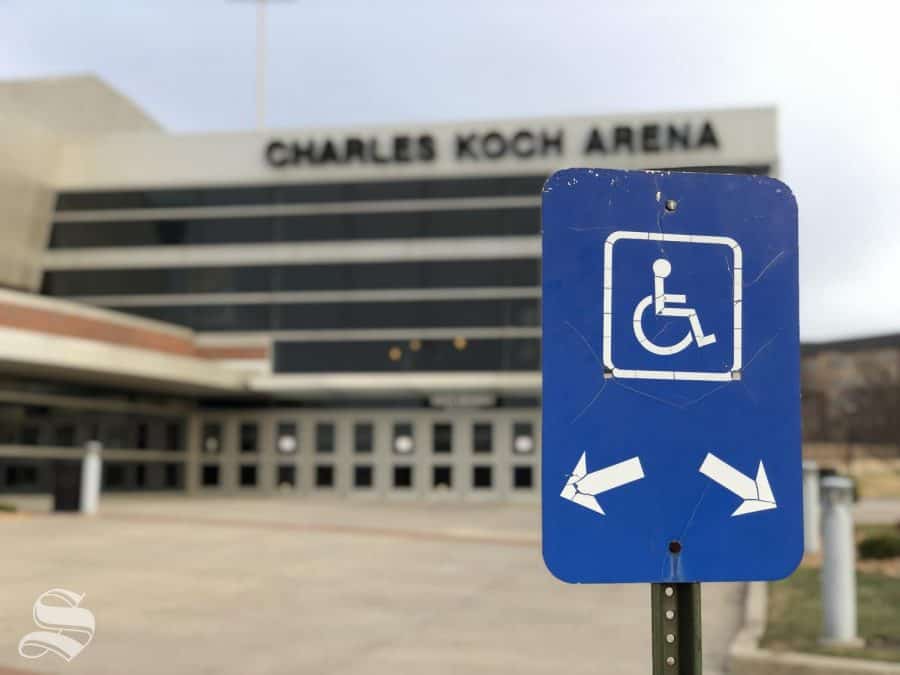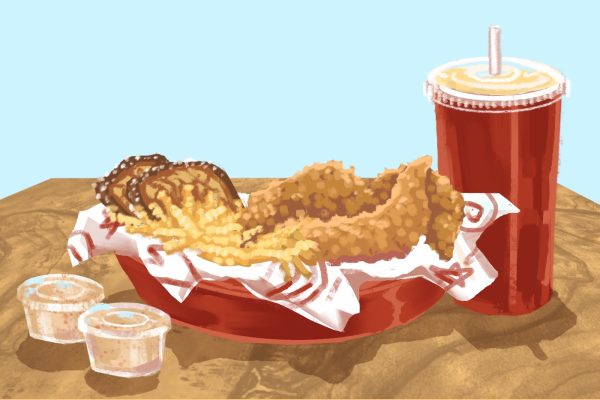OPINION: Dealing with invisible disabilities
Fans who typically use disability parking spots outside of Charles Koch Arena had to choose to either pay $10 to park their vehicle or walk in the cold, wintery rain Saturday night.
“You don’t look sick,” they said. “You look fine. You must be getting old.” I explain and sometimes they still do not understand, but that is one of the struggles of having an invisible disability.
The stigma around invisible disabilities needs to change. Yes, disabilities that are visible and invisible are a great struggle and one is not over the other. However, having an invisible disability comes with it’s own tough circumstances.
You may notice by how tired I am, the handicap parking spot I park in, the compression gloves I wear on my hand sometimes, or my swollen joints. However, what you can’t see is the inflammation in the lining of my joints that will continue to cause joint damage and bone erosion if not treated. You don’t see the sharp throbbing pain I feel everyday throughout my body, or the stiffness in my hands when I type and write with a pencil. You see me covering sports, and walking around campus like everyone else so you assume I’m fine. I’m not listing these factors for pity but for clarity. Pity is the last thing I want. I want to be understood.
I’m sure now you are wondering what my disability is. I have an autoimmune disease called Rheumatoid Arthritis. Rheumatoid is a form of arthritis that has no explained cause other than an overactive immune system. The way this disease works is from having an overactive immune system that attacks the lining of my joints which is called synovium. It most commonly affects my fingers, wrists, knees, shoulders, ankles, elbows, and jaw.
The symptoms include extreme fatigue, swollen and stiffness of my joints, sharp and throbbing pain throughout my body which causes disability. Some days it takes me hours to get ready in the morning, unable to do work or homework, and unable to do many physical activities that my peers participate in.
I have had people stigmatize me in more ways than I can count. I have gotten dirty looks as I am getting out of a handicap parking stall, and made fun of for not being able to go to the gym and run for miles. I have lost friends because I have been too tired to go out for the night, or because I cannot stand on my feet for longer than fifteen minutes.
Some do not get why I take seven different types of medication every morning since I am apparently so “young” or why I receive medication through an IV every month. They don’t understand that these treatments do not just reduce pain but slow down disease progression and save the inflammation in my body from affecting my heart or lungs.
Some people say you look okay so maybe you should change up your diet more, or maybe you are just really out of shape. While maintaining a healthy lifestyle helps the condition, the disability aspect of it is not going to go away.
The point I am trying to make is that people may look normal on the outside but that doesn’t mean they do not struggle. Please be kind when someone says that they are in pain but they look okay. Please try to have empathy and understand that they could be going through something extremely tough physically that you have no idea about.
I would not change my disability because it has made me a stronger person. However, please understand someone you might meet in life could have an invisible disability you do not know about so remember to be kind, and do not jump to conclusions.

Emmie Boese was the sports and opinion editor. Boese graduated with a degree in communications with an emphasis on journalism in May 2024.










EVA LELE • Dec 3, 2021 at 4:31 pm
HOW TO GET YOUR EX LOVER BACK & HOW I GOT MY EX LOVER BACK MY TRUE LIFE STORY HOW I GOT MY EX LOVER BACK.I want to thank Dr Omokpo for saving my marriage. My husband treated me badly and left home for almost 3 month this got me sick and confused. Then I told my friend about how my husband has changed towards me. Then he told me to contact: [email protected] that he will help me bring my husband back to being a good man.Then I gave him a try. after 3 days of casting the spell my husband came back home and i forgive him and today we are living in joy and happiness If you are going through any relationship stress or broken marriage situation and you want your Ex lover, Ex boyfriend, Ex girlfriend or Divorced husband or wife you can reach him via: [email protected]
RANDA ROSE • Sep 24, 2021 at 9:31 pm
GET YOUR EX LOVER BACK.
This is my testimony of life that I will tell everyone. I have been married for 25 years Another woman had a spell to get me away from my lover, My husband left me and the children and we suffered for 2 years until I saw post about where this man Dr Omokpo has helped so many people recover their broken marriages and relationships to get their ex lovers back. I decided to send him a message about my broken marriage and family about how my husband left me and for him to help me bring back my loving husband home, This great man told me what to do and I followed him as he instructed. After 48 hours, as he told me, I saw a car enter the compound. I was shocked when I saw my husband. As I share my testimony with you my husband came back to me and the kids and that’s why I’m happy to put all of you to meet this man for solutions to your problem and bring your lover back to you and mend your broken marriage or your relationship restored back to happiness as you wished. Contact this great man via: [email protected]
MARY CLARA • Sep 8, 2021 at 12:18 pm
Top Secret Way To Win Lottery With The Help Of A Magic PRIEST Call +1(419)359-4367
I saw testimonies online on how PRIEST OSAS helped a lot of people in winning huge amounts in the lottery, so I decided to contact him for winning numbers. I contacted this man and he did a spell and he gave me the winning lottery numbers. But believe me when the draws were out I was among the winners. I won FOURTEEN MILLION,FIVE HUNDRED AND NINE THOUSAND AND FIVE HUNDRED DOLLARS ($14,509,500) I have confirmed PRIEST OSAS is real and guaranteed. Now I am a living testimony of the good works of PRIEST OSAS, a gifted man with great powers, it is my secret but I decided to make the world known too. It might be a help to any one who is interested. My comment might look funny to you but it is the truth. And I promise you that it will not be funny when you win and share a testimony with others. This is a secret to winning the lottery so I advise you to do the same. It’s not everybody that is naturally lucky, if you have problems winning the lottery, the solution to win is PRIEST OSAS So contact him now for you to confirm my testimony.
Email: [email protected]
Call or text him:+1(419)359-4367
https://unsurpassedsolution.blogspot.com/
http://unsurpassedsolutionhome.website2.me/